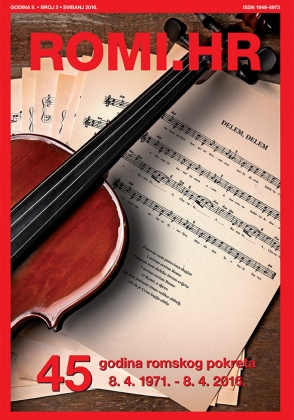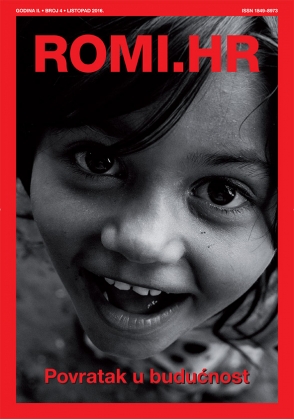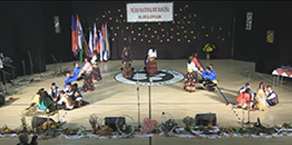Features ROMI.HR
/Roma people, often referred to as „Europe’s musicians“, have had a significant influence on the musical history of Europe. Finland has also witnessed this influence, particularly, in genres like Tango and Iskelmä, a piece of music which is made in schlager style, usually with facile, sentimental lyrics (from iskeä (“to hit”) + -lmä, a calque of German Schlagerlied (“hit song)). However, it has only been lately that the rich and distinctive musical traditions of the Roma in Finland have become known and gained widespread acknowledgement.
According to Suora Lähetys singer-guitarist Mertsi Lindgren, a Helsinki Pop & Jazz Conservatory alumnus, music still plays a fundamental role in Roma culture. “There is a lot of music-making in Roma families, just like in Finnish families in general. I guess the Roma mentality is a bit more sociable and positive compared to mainstream Finns, so maybe it is easier for us to bring our music forward,” says Lindgren.
The legendary Finnish Tango singer Olavi Virta was notably influenced by Roma singing styles. His success paved the way for other Roma performers to enter the public eye, although many of the early Roma singers decided to "finnishize" their names in order to gain wider acceptance. For example, Allan Isberg, a Finnish Iskelmä and Tango singer, became Markus Allan, while Taisto Lundberg adopted the stage name Taisto Tammi. According to to researcher Kai Åberg, the Roma prefer conventional musical genres and frequently avoid overly creative or experimental interpretations.
Roma music in Finland is distinguished from non-Roma performances by its unique repertoire and interpretation style. Music has always served as more than just amusement for the Kaale people (Roma from Finland); it is a living archive of their cultural history. With many Roma historically facing illiteracy, singing was the main way that the Roma people preserved and passed on their stories and customs from generation to generation. Both Finnish and Romani are used in traditional Roma music in Finland. Risto Blomster, Finnish archive researcher, points out that songs in Romani language were originally meant to be sung only within the community. Even the Finnish-language songs often contain hidden messages that only the Roma can fully understand. In recent years, these traditional songs have gained popularity, mostly due to highly successful performances of singers like Hilja Grönfors, award-winning Roma artist.
Since the 1960s, with the rise of public performances of Roma singers at festivals and other events, Roma music in Finland has experienced a revival. The quantity of new recordings and releases hasn't increased, though. In recent years, a new wave of interest has arisen, Roma tunes have been combined with modern genres like Rap and Flamenco. Through karaoke, singing competitions, and online platforms, young Roma artists are discovering their voices, allowing the tradition to evolve.
Voices of Roma Music in Finland
In Finland, a large number of Roma musicians had strong evangelical Christian backgrounds. This connection provided stage for Roma artists to become visible in society. Roma vocal groups like the Romanos and Freidiba Boodos gained fame in the Christian music starting in the 1970s.
In spite of this, Christian and non-religious music communities haven't really blended together. The ensemble Suora Lähetys, which rose to national prominence via talent competitions like “Talent Suomi” and “Eurovision”, is one of the few acts to close this gap. The group began as a trio of Roma singers, but it has since grown into an eight-piece band. They started off with Gospel music, moved on to Iskelmä, and are now exploring different musical genres.
There are also several Finnish performers with Roma roots, who gained popularity among Finnish and even worldwide audience:
The Åkerlunds
Roma artists Valfrid and Tuula Åkerlund have a vast repertoire of original songs, most notably - Roma Gospel compositions from the 1970s. At that time, a new generation of singer-songwriters appeared, and Roma Gospel music, which evolved from Roma Folk music in Finland, became popular among the Roma community in Finland. Choral ensembles sing some of the tunes, even though the majority were written for solo voices. Many Roma people in Finland are involved in Roma Gospel music these days. The Åkerlund family's numerous Gospel recordings and appearances at Roma Gospel music events have made them well-known throughout Finland and Sweden.
The pair was also performing and publishing traditional songs of Roma in Finland. Their daughter Anette Åkerlund has been carrying on this tradition and became a singer as well. Apart from their church concerts, Tuula and Valfrid accompany Anette in music festivals in the Roma music festivals. They have performed in locations around Europe, Asia, and America as a family band. In addition, Valfrid Åkerlund is an accordionist, pianist, and guitarist in a studio. Numerous Roma musicians in Finland have had their CDs recorded at his studio, Studio Miritz.
Hortto Kaalo
Finnish band Hortto Kaalo performs in both Finnish and Romani languages and specializes in Roma music. Their repertory incorporates elements of French Roma music and Eastern European music. Researcher Kai Åberg points out that Roma bands in Finland like Hortto Kaalo “have purposefully strengthened their cultural identity by incorporating elements from Roma music traditions across Europe”. The band's name translates as "real Roma" in Roma language, and they were successful in bringing Roma music to a wider audience in Finland. The 1970s saw Hortto Kaalo at the height of their fame. In 1977, their song "Kauan sitten" finished second in the Finnish Eurovision selection contest, narrowly losing to Monica Aspelund’s “Lapponia”.
Taisto Tammi
Taisto Tammi is a schlager singer from Finland. Being the first Roma singer from Finland to record, he became popular because of his interpretations of Toivo Kärki's Tangos. “Tango merellä”, “Tangotyttö”, and “Rakkauden rikkaus” were among his most well-known songs during the height of his fame in the early 1960s. He entered the 1964 Finnish national selection for the Eurovision Song Contest with the song “Tango merellä”, which was recorded in the spring of 1963, and it became a classic due to its enormous success. Tammi was selected as Finland's top male vocalist in 1964.
Aaltonen Remu
Born in Helsinki on January 10, 1948, Henry Olavi "Remu" Aaltonen is a well-known Roma drummer and singer from Finland, best known as the lead musician of the band Hurriganes. Aaltonen grew up in challenging conditions, with his family living in an abandoned train car near the construction of Helsinki Airport. In recognition of his impactful career in the arts, Aaltonen was awarded the Suomi-palkinto (Finland Award) by the Finnish Ministry of Education and Culture in 2018.
Hilja Grönfors
Hilja Grönfors is an award-winning artist. She has played a crucial role in preserving and promoting this rich heritage. Her great interest in the Roma culture and especially music forced Hilja to become a collector - she has spent thousands of kilometers on the road and by now she has a collection of more than 100 Kaale Roma songs from different regions of Finland. Hilja was nominated as Master Folk Singer at Kaustinen Folk Music Festival in 2005. She performs these songs with her band Latšo Džinta.
These musicians and groups demonstrate the deep connection between Roma culture and Finnish music, showing the long- standing influence of Roma culture on the country’s music. With the support of grants, television documentaries, and educational initiatives, the tradition of Roma music in Finland is developing more and more every year.
Songs of the Roma in Finland
Roma songs, also known as Kale songs, have traditionally been passed down orally, following stringent cultural guidelines. The unwritten laws of Roma culture, which specify proper conduct for men and women as well as between generations, are reflected in these songs. The lyrics, which are frequently filled with euphemisms, have deeper implications within the group that may not be immediately apparent to outsiders.
Roma in Finland have traditional songs with distinctive melodies, lyrics, and performance methods that set them apart from other Roma music from other nations. While certain songs have origins in centuries-old customs, adaptations of local Finnish songs have developed a distinct genre within Roma music. Examples of these include Rekilaulut (Sleigh songs), which are frequent four-line rhyming Folk songs with humorous themes that were previously sung while working and traveling.
 Back to Features
Back to Features













